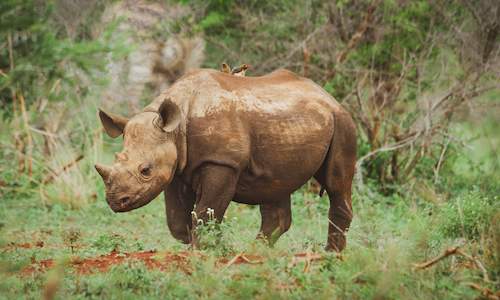Black Rhino Hunting More Info
The proposed hunting of black rhino by Ezemvelo KwaZulu-Natal Wildlife (EKZNW) is not an undertaking that has been rushed into.The proposed hunting of black rhino by Ezemvelo KwaZulu-Natal Wildlife (EKZNW) is not an undertaking that has been rushed into. In 1992, the IUCN (World Conservation Union) African Rhino Specialist Group discussed the problem of excess male black rhino that rhino farmers were facing. After more than a decade of debate and research, this initial discussion has resulted in the Convention on the International Trade in Endangered Species of Flora and Fauna (CITES) authorising both Namibia and South Africa to hunt five black rhino each year, provided certain conditions are met.
This decision was reached last October at the 13th Conference of the Parties of CITES held in Bangkok. Since then, EKZNW has initiated a public debate regarding the hunting, to be held on April 9, 2005. The black rhino population in South Africa has grown from 110 animals in 1930 to approximately 1,200 animals in 24 populations around the country in 2003. Since the 1960s the population growth has been accelerated by moving black rhino to new protected areas, principally from Hluhluwe-Umfolozi and Mkuze provincial parks.
Within the rhino populations around the country, there is a problem of too many male animals. The excess of males is caused by a number of factors, including the fact that in some populations more male rhino are born than female rhino. It has also been found that the best way to start a new black rhino population in a new area is by introducing a "seed" population of two male and four female animals. This means that the rhino population that the seed animals are taken from is left with extra male rhino.
In populations where there are too many males, there is often territorial fighting that causes serious injuries and sometimes the death of animals. This unfortunately can also involve breeding females and their calves, whose losses will harm the breeding success of the entire rhino population.
Past attempts to manage excess male rhino have included the sale of animals to zoos, or the creation of male-only populations on reserves that have suitable black rhino habitat but not enough room for a breeding population. However, there has not been much demand for live males, and male-only populations are not that popular. In 2003 it was estimated that rhino conservation costs are about US$1200 per km2. Government funding of conservation has declined in real terms over the years, necessitating other revenue sources to be investigated to maintain conservation standards.
In white rhino conservation, hunting is one of the ways that revenue is generated, both by the state and by private farmers. It is felt that if the male black rhino get a value through hunting, more private organi- sations would be willing to keep them. The hunting will also provide more funds for future rhino conservation. Hunting will be subject to certain national and CITES conditions.
EKZNW created a strategy for the disposal of the excess males that states that hunting can only occur after other options have been explored. These include translocation to other areas, adding the animal to a productive rhino group that is for sale or donation, using the male to provide new genetic material to smaller populations, donating the animal to a low-risk area where it will live to be a source of genetic variability, or selling the rhino to a zoo or private stakeholder.
If none of these conditions are met, excess males that are too old to reproduce or are considered to be problem animals will be hunted. Prices have not been determined yet, but are expected to be in excess of the price of hunting a white rhino, which can be over R250,000. Some trade experts and conservationists have stated that with this high price, it is unlikely that the horns from these rhino hunts will enter the illegal trade.
The horns will also be specially marked before they can be exported from the country. About 70 white rhino horns leave the country in this same manner at present. The loss of five post-reproductive animals from a population of over 1,000 animals is considered to be biologically sound and sustainable.

Bulls weigh up to 1 200 Kg and cows about 800 Kg. As such this species is smaller than the White Rhino. It can further be distinguished from...
more
